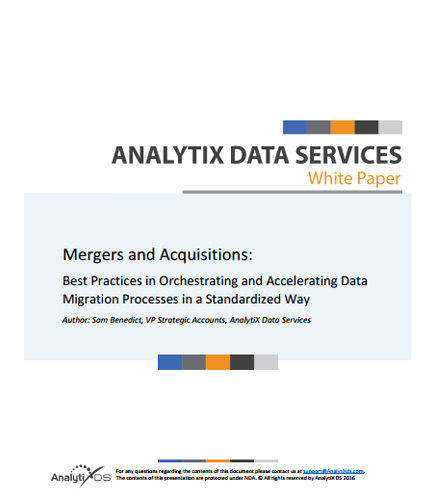
PROCESSING. PLEASE WAIT...

White Paper: Analytix Data Services
The Mergers and Acquisitions (M&A) process brings with it a broad range of complexity, from contracts and accounting, to organizational structure and employee protocols. The primary reason many mergers and acquisitions do not deliver longer-term value is because they lack a strong cultural-integration plan.
This whitepaper seeks to provide how the data related issues that come with combining disparate source data as is often the case in mergers and acquisitions can be addressed.
How to avoid Common Pitfalls in Mergers and Acquisitions?
More than 80 percent of all mergers and acquisitions fail. Why?
Best Practices in Orchestrating and Accelerating Data Migration Processes in a Standardized Way
Features of a typical merger or acquisition data project using a resource-driven approach
Pain points in mergers and acquisitions that begin with basic decisions about how the organizations involved, align with one another
Best tool to standardize the data migration process that can eliminate the error prone and costly manual process in managing complex data migration projects?
Best features and functionality offered by AnalytiX Data Services’ flagship product AnalytiX Mapping Manager
In this whitepaper, there are few out-of-the-box answers for streamlining this process, and though there are many system integration companies available to help, this can add significant cost and time to the Merger & Acquisition cycle.

By: Service Objects
Collecting visitor and customer data through a variety of channels allows you to quickly grow your contact list. However, receiving high quality data isn’t necessarily a given. Whatever your touch points are with customers or prospects – including customer data, contest entry forms, phone surveys, lead generation and point of sale interactions – some data will be inaccurate, incomplete, or fraudulent. So how can your company avoid the challenges associated with bad data? Download this white paper and learn how to identify areas that could benefit from improved data quality, realign your data quality goals to improve your bottom line, optimize your human capital and even help the environment.
By: Stone Bond Technologies
The Data Warehouse (DW) has been around some thirty years as essentially a repository forstoring corporate data. The effort to define, design, and implement new data sets in a data warehouse results in backlogs that are prohibitive to support the fast pace of today’s data needs. Most companies will continue to use their Data Warehouse as they move to the more agile approach, but they will rely on it mostly as a historical data repository for reporting and analytics. The Logical Data Warehouse (LDW) is a new data management architecture for analytics which combines the strengths of traditional repository warehouses with alternative data management and access strategy. Read in this White Paper on Data Warehouse: An overview on Data Virtualization for Logical Data Warehouse Challenges with Classical Data Warehouse A case for a new generation of data access (LDW) Logical Data Warehouse for Business Intelligence Leveraging Data Virtualization for next generation Data Warehouses Data Virtualization for Logical Data Warehouse


 2025 All Rights Reserved | by: www.ciowhitepapersreview.com
2025 All Rights Reserved | by: www.ciowhitepapersreview.com